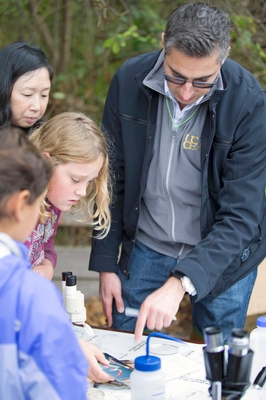
A colleague recently shared a simple statement with me that sums up this enigma educators inevitable experience: It is scary. It is real. It is us. There is hope.
Frameworks, a respected climate change think tank has come up with six narratives that help diffuse the topic and inspire others to learn more.
1. Make it do-able and show change is possible. People need hope in a hopeless world. Planting a tree is a simple and accessible action that almost anyone can do.
2. Focus on the big things and how we can change. Sometimes big things can be overwhelming, but getting trapped in circular arguments will not advance our work. It is time to roll up our sleeves and go about making change now.
3. Normalize action and change, not inaction. Many people still feel that nothing can be done. But there are thousands, if not millions of people working hard everyday on solutions that will lessen the burden.
4. Connect the planet's health with our own health. Remind others that our health and well-being goes hand and hand with the planet's. Share values that others can relate to.
5. Emphasize our responsibility to young people and future generations. Everyone has someone younger than them that they care about. Focus messaging on creating a future for them.
6. Keep it down to earth. There is no place for complexity now. Straightforward messaging over scientific jargon will be more accessible to more people. The more people who understand, the more positive action will result.
Here are some reputable resources to inspire action among young learners.
National Resources
- Columbia Climate School
- Google Earth Education
- Project Learning Tree, Forestry Institute for Teachers, and Project WET
- Green Schools America
- National Ocean Atmospheric Administration and other online resources
- Scripps Institute of Oceanography
- USGS (United State Geographic Society) Water Science School
- University Corporation of Academic Research Center for Science Education and the Teaching Box
- National Geographic Society Education Resources
- NASA (National Atmospheric Space Administration) Professional Development opportunities for teachers
- Rutgers University Climate Change Educator Resources
- North American Association for Environmental Education teacher professional development
- AEOE (Association for Environmental and Outdoor Education) Teacher Resources
Locally, here in Ventura County, I recommend checking out:
- SEEAG
- MERITO Foundation
- Once Upon a Watershed
- Ventura Wild
- Chumash Indian Museum
- Ventura County Resource Conservation District
- Ventura County Office of Education
Communicating about climate change can be uncomfortable at first. It may not seem like a topic that young people will understand. By simplifying your messaging and using values and metaphors that most everyone understand you can circumnavigate disinformation and lead the conversation toward solutions.